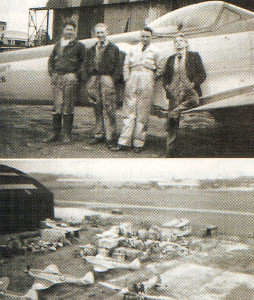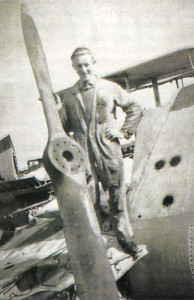
Above: Vickers’ Eastleigh in 1949, with Brian Simpson standing in front of a Seafire 15. The photograph was taken from the roof of Eastleigh Flight Shed.
THE 50th anniversary of the last Spitfire to be completed and delivered to the RAF fell on April 4 this year. Although there are many stories about the first flight of the first Spitfire, K5054, in March 1936, no-one seems to have written much about the last Spitfire to be built.
Towards the end of 1948, when the Vickers Supermarine Works at South Marsdon, near Swindon, needed more space to build the jigs for the ‘Attacker’ navel jet fighter production line, there were still four Spitfire Mk 24s being finished. Three had been returned from the RAF for modifications but the last one, VN496, had never been completed or flown. The fact that the production line had finished in February 1948 is possibly the reason why some books on the Spitfire say that the last plane was produced in February 1948.
The four Mk24 Spitfires were sent by road to Vickers Supermarine’s Main Works at Eastleigh Airfield (now called Southampton Airport) for completion and delivery to the RAF.
When most of the work was completed they were towed by tractor across Eastleigh Airfield to the test flight shed, which was near the end of the runway. At this time Eastleigh Main Works were busy refurbishing Spitfires and Seafires for the RAF and FAA.
I was working in the flight shed during this time as the electrician in the test flight gang which consisted of three fitters as well as myself. After each test flight any faults were rectified, and this was repeated over a number of days until 100% OK. Then the aircraft were made ready (cleaned and painted) for delivery to the RAF by our
pilots or to the FAA by Navy pilots.
On the day of delivery to the RAF, VN496 the last Spitfire was pushed out from the hangar on to the apron and fuelled up. Just before the flight, for safety reasons, I installed the radio and batteries.
Sqn. Ldr. Guy Morgan, our deputy Chief Test Pilot, climbed in and buckled up. He then went through his pre-flight checks, ran up his engine and gave the thumbs-up for chocks away. He taxied on to the grass runway, turned and took off, flying over South Stoneham Cemetery, about 200yds from the end of the runway.
This took place on April 4 1949. In South Stoneham Cemetery lie the remains of R. J. Mitchell, the designer of the Spitfire – so perhaps it was fitting that the last Spitfire to be built flew over the grave of the man who gave this country the greatest fighter plane in history. It also seems appropriate that the last Spitfire of more than 20,000 produced should have flown off the same airfield as the first, K5054, which had made its maiden flight there 13 years previously in March 1936.
I’ve always been proud to have been the last person to have completed the last job on the last Spitfire ever produced.
Brian Simpson









